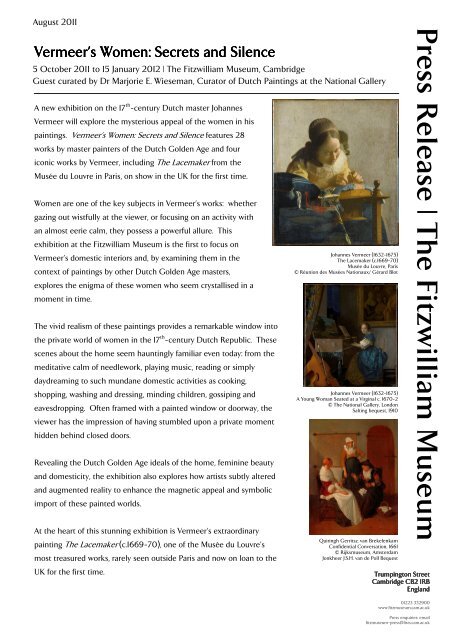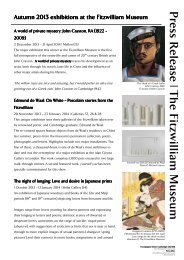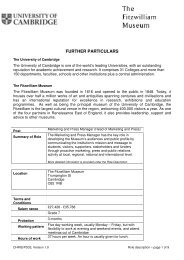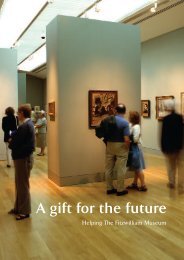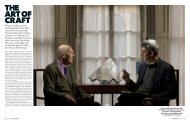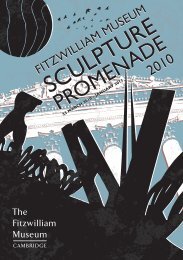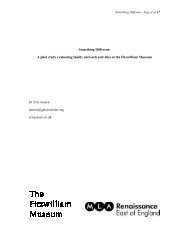Download press release - The Fitzwilliam Museum
Download press release - The Fitzwilliam Museum
Download press release - The Fitzwilliam Museum
You also want an ePaper? Increase the reach of your titles
YUMPU automatically turns print PDFs into web optimized ePapers that Google loves.
August 2011<br />
Vermeer’s Vermeer’s Women: Women: Secrets Secrets and and Silence<br />
Silence<br />
5 October 2011 to 15 January 2012 | <strong>The</strong> <strong>Fitzwilliam</strong> <strong>Museum</strong>, Cambridge<br />
Guest curated by Dr Marjorie E. Wieseman, Curator of Dutch Paintings at the National Gallery<br />
A new exhibition on the 17 th -century Dutch master Johannes<br />
Vermeer will explore the mysterious appeal of the women in his<br />
paintings. Vermeer’s Women: Secrets and Silence features 28<br />
works by master painters of the Dutch Golden Age and four<br />
iconic works by Vermeer, including <strong>The</strong> Lacemaker from the<br />
Musée du Louvre in Paris, on show in the UK for the first time.<br />
Women are one of the key subjects in Vermeer’s works: whether<br />
gazing out wistfully at the viewer, or focusing on an activity with<br />
an almost eerie calm, they possess a powerful allure. This<br />
exhibition at the <strong>Fitzwilliam</strong> <strong>Museum</strong> is the first to focus on<br />
Vermeer’s domestic interiors and, by examining them in the<br />
context of paintings by other Dutch Golden Age masters,<br />
explores the enigma of these women who seem crystallised in a<br />
moment in time.<br />
<strong>The</strong> vivid realism of these paintings provides a remarkable window into<br />
the private world of women in the 17 th -century Dutch Republic. <strong>The</strong>se<br />
scenes about the home seem hauntingly familiar even today: from the<br />
meditative calm of needlework, playing music, reading or simply<br />
daydreaming to such mundane domestic activities as cooking,<br />
shopping, washing and dressing, minding children, gossiping and<br />
eavesdropping. Often framed with a painted window or doorway, the<br />
viewer has the im<strong>press</strong>ion of having stumbled upon a private moment<br />
hidden behind closed doors.<br />
Revealing the Dutch Golden Age ideals of the home, feminine beauty<br />
and domesticity, the exhibition also explores how artists subtly altered<br />
and augmented reality to enhance the magnetic appeal and symbolic<br />
import of these painted worlds.<br />
At the heart of this stunning exhibition is Vermeer’s extraordinary<br />
painting <strong>The</strong> Lacemaker (c.1669-70), one of the Musée du Louvre’s<br />
most treasured works, rarely seen outside Paris and now on loan to the<br />
UK for the first time.<br />
Johannes Vermeer (1632-1675)<br />
<strong>The</strong> Lacemaker (c.1669-70)<br />
Musée du Louvre, Paris<br />
© Réunion des Musées Nationaux/ Gérard Blot<br />
Johannes Vermeer (1632-1675)<br />
A Young Woman Seated at a Virginal c. 1670-2<br />
© <strong>The</strong> National Gallery, London<br />
Salting bequest, 1910<br />
Quiringh Gerritsz. van Brekelenkam<br />
Confidential Conversation, 1661<br />
© Rijksmuseum, Amsterdam<br />
Jonkheer J.S.H. van de Poll Bequest<br />
Press Release | <strong>The</strong> <strong>Fitzwilliam</strong> <strong>Museum</strong><br />
Trumpington Trumpington Street<br />
Street<br />
Cambridge Cambridge Cambridge CB2 CB2 1RB<br />
1RB<br />
England<br />
England<br />
01223 332900<br />
www.fitzmuseum.cam.ac.uk<br />
Press enquiries: email<br />
fitzmuseum-<strong>press</strong>@lists.cam.ac.uk
Complementing this painting are three further works representing the<br />
pinnacle of Vermeer’s mature career: A lady at the virginals with a<br />
gentleman ‘<strong>The</strong> Music Lesson’ (c.1662-5) on loan from <strong>The</strong> Royal<br />
Collection; A Young Woman Seated at a Virginal (c.1670) from the<br />
National Gallery, London; and Young Woman Seated at a Virginal<br />
(private collection, New York). Joining these are 28 masterpieces of<br />
genre painting from such artists as Cornelis de Bisschop, Gerard ter<br />
Borch, Esaias Boursse, Quiringh van Brekelenkam, Gerrit Dou, Pieter de<br />
Hooch, Samuel van Hoogstraten, Nicolaes Maes, Cornelis de Man,<br />
Eglon van der Neer, Jacob van Ochtervelt, Godfried Schalcken, Jan<br />
Steen and Jacobus Vrel.<br />
Dr Timothy Potts, Director of the <strong>Fitzwilliam</strong> <strong>Museum</strong>, commented:<br />
“Vermeer’s Women will be a rare opportunity to enjoy some of<br />
Vermeer’s most ravishingly beautiful paintings of the intimacy of the<br />
Dutch household – frozen moments captured in Vermeer’s uniquely<br />
luminous style. Although domestic scenes constitute the principal<br />
subject of Vermeer’s work and that of many of his contemporaries, and<br />
are one of the most distinctive and evocative aspects of Dutch art of<br />
the Golden Age, this will be the first exhibition to focus exclusively on<br />
them, and to explore their hidden significance in terms of<br />
contemporary Dutch mores.<br />
“Equally importantly, Vermeer’s Women will reveal the extraordinary subtlety and skill of Vermeer’s<br />
finest contemporaries, many of whom were far more famous than Vermeer during their lifetimes.”<br />
<strong>The</strong> exhibition is guest curated by Dr Marjorie E. Wieseman, Curator of Dutch Paintings at the<br />
National Gallery, London. A new catalogue will be accompanying the exhibition, with essays by Dr<br />
Wieseman and two other internationally recognised experts in the field, Dr Wayne E. Franits,<br />
professor and chair of the Department of Fine Arts, Syracuse University, and Dr H. Perry Chapman,<br />
professor of art history at the University of Delaware.<br />
Vermeer’s Women: Secrets and Silence features works from museums and collections around the<br />
world, including the National Gallery, London; <strong>The</strong> Royal Collection; the Musée du Louvre; the<br />
Rijksmuseum, Amsterdam; the Mauritshuis, <strong>The</strong> Hague; and the Metropolitan <strong>Museum</strong> of Art, New<br />
York.<br />
- ENDS -<br />
For For further further information information information and and images images images please please co contact co contact<br />
ntact: ntact<br />
Sue Bond Public Relations<br />
Hollow Lane Farmhouse, Hollow Lane, Thurston, Bury St Edmunds, Suffolk IP31 3RQ, UK<br />
Tel. +44 (0)1359 271085, Fax. +44 (0)1359 271934<br />
E-mail. info@suebond.co.uk, Website. www.suebond.co.uk<br />
Pieter de Hooch (1629-1684)<br />
<strong>The</strong> Courtyard of a House in Delft, 1658<br />
© <strong>The</strong> National Gallery, London<br />
Bought, 1871<br />
Jacobus Vrel (fl. 1654-1670?)<br />
Woman at a Window, waving at a Girl c. 1650<br />
© Fondation Custodia, Collection Frits Lugt,<br />
Paris<br />
Press Release | <strong>The</strong> <strong>Fitzwilliam</strong> <strong>Museum</strong><br />
Trumpington Trumpington Street<br />
Street<br />
Cambridge Cambridge Cambridge CB2 CB2 1RB<br />
1RB<br />
England<br />
England<br />
01223 332900<br />
www.fitzmuseum.cam.ac.uk<br />
Press enquiries: email<br />
fitzmuseum-<strong>press</strong>@lists.cam.ac.uk
FACT FACT SHEET<br />
SHEET<br />
Exhibition Exhibition<br />
Exhibition<br />
title:<br />
title:<br />
Vermeer’s Vermeer’s Vermeer’s Vermeer’s Women: Women: Women: Women: Secrets Secrets Secrets Secrets and and and and Silence Silence Silence Silence<br />
Dates: Dates: Dates: 5 October 2011 – 15 January 2012<br />
Location: Location: <strong>The</strong> <strong>Fitzwilliam</strong> <strong>Museum</strong>, Trumpington Street, Cambridge CB2 1RB<br />
www.fitzmuseum.cam.ac.uk<br />
Telephone: +44 (0)1223 332900<br />
Admission: Admission: FREE<br />
Opening<br />
Opening<br />
hours:<br />
hours:<br />
Permanent<br />
Permanent<br />
collection:<br />
collection:<br />
OPEN: Tuesday - Saturday: 10.00 - 17.00<br />
Sundays and Bank Holiday Mondays: 12.00 - 17.00<br />
CLOSED: 24, 25, 26 and 31 December 2011 and 1 January 2012<br />
<strong>The</strong> <strong>Fitzwilliam</strong> <strong>Museum</strong> houses the University of Cambridge's art collection<br />
and is a public museum and art gallery with an international reputation. More<br />
than half a million objects and works of art are held in five curatorial<br />
departments: Antiquities, Applied Arts, Coins and Medals, Manuscripts and<br />
Printed Books and Paintings, Drawings and Prints. <strong>The</strong> <strong>Fitzwilliam</strong>’s treasures<br />
range from Ancient Egyptian, Greek and Roman antiquities to the arts of the<br />
21 st century and include masterpieces by Titian, Canaletto, Stubbs, Constable,<br />
Monet, Renoir and Picasso, one of the world’s foremost Rembrandt print<br />
collections, Handel music manuscripts and the famous <strong>Fitzwilliam</strong> Virginal<br />
Book, one of the most significant collections of Korean ceramics outside<br />
South-East Asia, medieval illuminated manuscripts and outstanding collections<br />
of pottery, porcelain and medieval coins. <strong>The</strong> <strong>Fitzwilliam</strong> <strong>Museum</strong> welcomes<br />
over 350,000 visitors a year, offers a wide-ranging programme of temporary<br />
exhibitions and events, and has an award-winning Education Service.<br />
For all <strong>press</strong> enquiries relating to the permanent collection please contact<br />
Lucy <strong>The</strong>obald at the <strong>Fitzwilliam</strong> <strong>Museum</strong>: Tel. +44(0)1233 332941<br />
E-mail: <strong>press</strong>@fitzmuseum.cam.ac.uk<br />
Catalogue: Vermeer’s Women: Secrets and Silence<br />
Publication date: 5 October 2011, Price: £20<br />
Centering on the extraordinary Lacemaker from the Musée du Louvre, this<br />
beautiful book investigates the subtle and enigmatic paintings by Johannes<br />
Vermeer that celebrate the intimacy of the Dutch household. Three<br />
internationally recognised experts in the field explain why women engaged in<br />
mundane domestic tasks, or in pleasurable pastimes such as music making or<br />
writing letters, in some of the most popular Dutch paintings of the 17th century.<br />
<strong>The</strong> book also features works by some of the most important masters of 17thcentury<br />
Dutch genre painting, among them Gerard ter Borch, Gerrit Dou, Pieter<br />
de Hooch, Nicolaes Maes, and Jan Steen.<br />
With essays by:<br />
Dr Marjorie E. Wieseman, curator of Dutch paintings 1600-1800 at the National<br />
Gallery, London.<br />
Dr Wayne E. Franits, professor and chair of the Department of Fine Arts, Syracuse<br />
University<br />
Dr H. Perry Chapman, professor of art history at the University of Delaware<br />
All <strong>press</strong> enquiries about the book to Heather Nathan at Yale University Press:<br />
Tel. 020 7079 4900, E-mail. heather.nathan@yaleup.co.uk<br />
Press Release | <strong>The</strong> <strong>Fitzwilliam</strong> <strong>Museum</strong><br />
Trumpington Trumpington Street<br />
Street<br />
Cambridge Cambridge Cambridge CB2 CB2 1RB<br />
1RB<br />
England<br />
England<br />
01223 332900<br />
www.fitzmuseum.cam.ac.uk<br />
Press enquiries: email<br />
fitzmuseum-<strong>press</strong>@lists.cam.ac.uk


